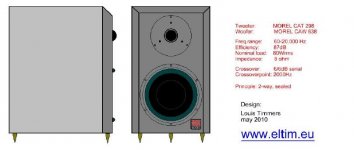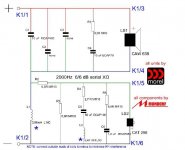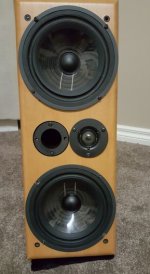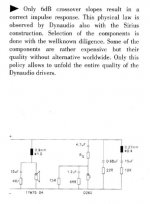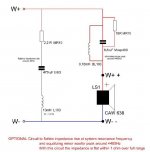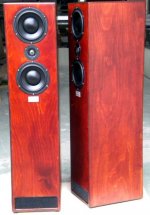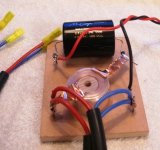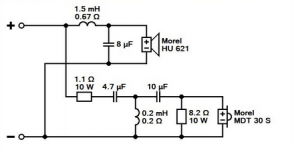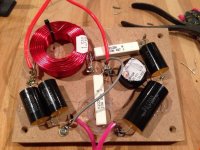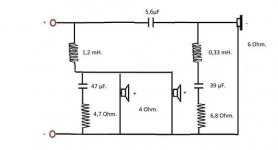Hello everybody!
I have a pair of DIY speakers using a pair of Morel CAW638 woofers and a Morel CAT408 tweeter in an MTM design. Baffle is 24cm wide.
The current crossover is a very simple one, 7.27µF cap (6.8µF + 0.47µF) and a 0.27mH inductor coil.
I know absolutely nothing about crossovers and crossover design so maybe you can help me out a bit? I asked in a Facebook group and was recommended this

It makes very little sense to me and I have no idea whether or not it's a good starting point for a new crossover.
What would you recommend? And why?
I have a pair of DIY speakers using a pair of Morel CAW638 woofers and a Morel CAT408 tweeter in an MTM design. Baffle is 24cm wide.
The current crossover is a very simple one, 7.27µF cap (6.8µF + 0.47µF) and a 0.27mH inductor coil.
I know absolutely nothing about crossovers and crossover design so maybe you can help me out a bit? I asked in a Facebook group and was recommended this

It makes very little sense to me and I have no idea whether or not it's a good starting point for a new crossover.
What would you recommend? And why?
No experience ? No measuring instruments? Then try this:Crossover Design: Madisound Loudspeaker Parts: Raw Speaker Drivers and Passive Crossover Parts
I think asking Madisound to do it for you is not very diy! 
Firstly could you elaborate on what you have right now. I would guess the basses are running direct, and the tweeter has the series capacitor and the shunt coil? A second order tweeter filter?
This shouldn't be too hard. One of our moderators knows a thing or two about Morel drivers, too.
These are excellent and expensive drivers which can work OK on the simple filters, but we like to do a proper job for the top sound.

What you have there is a simple coil and cap filter, better than your current effort, because you have impedance correction on the bass units for 6dB slope, and correction of the tweeter resonance for another smooth slope. Again 6dB/octave (electrically), IIRC.
Before I build it, I would want to know the values are correct. I'm busy right now, and would only do this if you are serious about the project, but we need to look at the frequency response and impedance of the drive units to see if it all looks reasonable. The homework to take out the guesswork.
The stuff below won't make a lot of sense initially, except to suggest this has been done before, but us filter people undersand it all instantly. 😎

Firstly could you elaborate on what you have right now. I would guess the basses are running direct, and the tweeter has the series capacitor and the shunt coil? A second order tweeter filter?
This shouldn't be too hard. One of our moderators knows a thing or two about Morel drivers, too.
These are excellent and expensive drivers which can work OK on the simple filters, but we like to do a proper job for the top sound.

What you have there is a simple coil and cap filter, better than your current effort, because you have impedance correction on the bass units for 6dB slope, and correction of the tweeter resonance for another smooth slope. Again 6dB/octave (electrically), IIRC.
Before I build it, I would want to know the values are correct. I'm busy right now, and would only do this if you are serious about the project, but we need to look at the frequency response and impedance of the drive units to see if it all looks reasonable. The homework to take out the guesswork.
The stuff below won't make a lot of sense initially, except to suggest this has been done before, but us filter people undersand it all instantly. 😎
Attachments
Last edited:
Hello everybody!
What would you recommend? And why?
I am always interested in poly cone woofers technology so I will make you a filter proposal and a drawing of a baffle. Have you decided how much enclosure volume would be acceptable? Smaller ones lack woofer output. 30-40 liters would be enough to employ all the capabilitities these units have.
The crossover you post is probably a good start. Some of the values, take for example the RLC across the tweeter need to be selected carefully using measurement of some sort to work properly.
No experience ? No measuring instruments? Then try this:Crossover Design: Madisound Loudspeaker Parts: Raw Speaker Drivers and Passive Crossover Parts
No experience, but I have a MiniDSP UMIK-1 measuring microphone and a multimeter.
I think asking Madisound to do it for you is not very diy!
Firstly could you elaborate on what you have right now. I would guess the basses are running direct, and the tweeter has the series capacitor and the shunt coil? A second order tweeter filter?
This shouldn't be too hard. One of our moderators knows a thing or two about Morel drivers, too.
These are excellent and expensive drivers which can work OK on the simple filters, but we like to do a proper job for the top sound.

What you have there is a simple coil and cap filter, better than your current effort, because you have impedance correction on the bass units for 6dB slope, and correction of the tweeter resonance for another smooth slope. Again 6dB/octave (electrically), IIRC.
Before I build it, I would want to know the values are correct. I'm busy right now, and would only do this if you are serious about the project, but we need to look at the frequency response and impedance of the drive units to see if it all looks reasonable. The homework to take out the guesswork.
The stuff below won't make a lot of sense initially, except to suggest this has been done before, but us filter people undersand it all instantly. 😎
The tweeter have only the caps and the coil is for the woofers, so first order?
What values are you wondering about if they are correct? I am serious about the project. I built these when I was just a kid in high school with little knowledge and money. Now I have a well paid job that gives me plenty of spare time (working 12hr shifts 3 times a week) so I don't mind spending a little money on improving these speakers. As you say, they are good and expensive drivers and I feel like they aren't being used to their full potential with the current crossover, which is a shame I think.
I am always interested in poly cone woofers technology so I will make you a filter proposal and a drawing of a baffle. Have you decided how much enclosure volume would be acceptable? Smaller ones lack woofer output. 30-40 liters would be enough to employ all the capabilitities these units have.
I have nice cabinets in 18mm top quality birch ply already. Cabinets are ~53.8L not excluding volume of drivers, braces, port, etc. So net volume is probably around 50L. Baffle is 100cm tall and 24cm wide (39.37" x 9.45"). Bass output is plentiful and well enough for my apartment.
When I suggested "Crossover Design: Madisound Loudspeaker Parts: Raw Speaker Drivers and Passive Crossover Parts" I meant the design only, not the actual crossover, my advice was only to try to help him save his time and money, capacitors and coils are not cheap, his drivers are not cheap either.
Have you learned how to measure speakers with a microphone?
I think I have a basic grasp of how it works, but I'm sure there's more for me to learn.
I had a little go at this one, but if Lojzek is on it, I'll keep largely schtumm here. 😀

I don't know what this is at all really. It isn't right for the CAT 408 on the 800Hz Fs correction at all. At the bass end the coil seems excessive, and the impedance correction looks overdone.
The Frequency response of the Morel CAW 638 is quite challenging, but might be OK on a coil and impedance corrrection like 0.6mH and 4.7R plus 27uF. I seemed to get a second order tweeter too, which actually wasn't too bad on existing 6.8uF and 0.27mH with the usual option of a ca. 2.2R resistor at the input for level adjust. People have also used a 4.4kHz trap on that bump but I didn't go into that. I had these files, because I think we did this one a while back.

I don't know what this is at all really. It isn't right for the CAT 408 on the 800Hz Fs correction at all. At the bass end the coil seems excessive, and the impedance correction looks overdone.
The Frequency response of the Morel CAW 638 is quite challenging, but might be OK on a coil and impedance corrrection like 0.6mH and 4.7R plus 27uF. I seemed to get a second order tweeter too, which actually wasn't too bad on existing 6.8uF and 0.27mH with the usual option of a ca. 2.2R resistor at the input for level adjust. People have also used a 4.4kHz trap on that bump but I didn't go into that. I had these files, because I think we did this one a while back.
Attachments
Last edited:
I knew I'd seen this one before: Dynamics, brute force and resolution with tiny feet.
Fat lot of use the whole 10 pages and blog are though. Thanks to photobucket the whole thing is unreadable, and Ingvar didn't help by not posting the two component values. I think he used something similar to your simple ones.
Oh wait, this couldn't be the same CAW 638, CAT 408 speaker, could it? 😀
Fat lot of use the whole 10 pages and blog are though. Thanks to photobucket the whole thing is unreadable, and Ingvar didn't help by not posting the two component values. I think he used something similar to your simple ones.
Oh wait, this couldn't be the same CAW 638, CAT 408 speaker, could it? 😀
Attachments
Steve, take it away as you please. I just wanted to encourage the OP to proceed with learning how to use measurements and then simulate.
I love 6" bass as much as catching the 'flu. 🙄
But a polycone always seems like a reasonable proposition with 6".
AFAIK, most of the Morel 6" drivers are much the same: Old MOREL Driver Datasheets - DIY-loudspeakers.com
So I had a dig round, since I see no point in reinventing the wheel.
I thought this one was a bit prissy: MoreTrix Morel 2-Way Speaker Kit, Pair
And I found some sort of "Duet" sloped baffle below. Which looks like stuff I have built. Maybe I'd add a ca. 5kHz notch and do the usual MTM adjustment. IDK.
And then we have the original proposition, which I thought might be knocked into some sort of more conventional shape.
All wildly different approaches. I'm not sure I like any of them. Which is why I preferred to leave it to you. 😀
But a polycone always seems like a reasonable proposition with 6".
AFAIK, most of the Morel 6" drivers are much the same: Old MOREL Driver Datasheets - DIY-loudspeakers.com
So I had a dig round, since I see no point in reinventing the wheel.
I thought this one was a bit prissy: MoreTrix Morel 2-Way Speaker Kit, Pair
And I found some sort of "Duet" sloped baffle below. Which looks like stuff I have built. Maybe I'd add a ca. 5kHz notch and do the usual MTM adjustment. IDK.
And then we have the original proposition, which I thought might be knocked into some sort of more conventional shape.
All wildly different approaches. I'm not sure I like any of them. Which is why I preferred to leave it to you. 😀
Attachments
I knew I'd seen this one before: Dynamics, brute force and resolution with tiny feet.
Fat lot of use the whole 10 pages and blog are though. Thanks to photobucket the whole thing is unreadable, and Ingvar didn't help by not posting the two component values. I think he used something similar to your simple ones.
Oh wait, this couldn't be the same CAW 638, CAT 408 speaker, could it? 😀
Yes, that's the speaker I've got! I have tried getting in touch with Ingvar but it seems he disappeared from the earth. My crossover looks like the one in that picture but with another 0.47 microfarad capacitor next to the big one.
This might have been added by a previous owner. It might not be necessary.with another 0.47 microfarad capacitor next to the big one.
This might have been added by a previous owner. It might not be necessary.
I am the only owner since I built these myself (bought a flat pack from Ingvar many years ago).
Hi Niklas ( I believe )
Over the last few days I've worked up ( more than ) a few networks for you to try out, but before I post them I'd like to see you acquire ( & then post ) the necessary data required for determining the acoustic offsets that occur between your 2 driver types.
This offset info is necessary before an accurate design can be made ( and only the owners of the drivers can actually acquire it ).
So, are you up for making some measurements ( on your UMIK-1 mic into REW ) ?
🙂
Over the last few days I've worked up ( more than ) a few networks for you to try out, but before I post them I'd like to see you acquire ( & then post ) the necessary data required for determining the acoustic offsets that occur between your 2 driver types.
This offset info is necessary before an accurate design can be made ( and only the owners of the drivers can actually acquire it ).
So, are you up for making some measurements ( on your UMIK-1 mic into REW ) ?
🙂
Last edited:
Hi Niklas ( I believe )
Over the last few days I've worked up ( more than ) a few networks for you to try out, but before I post them I'd like to see you acquire ( & then post ) the necessary data required for determining the acoustic offsets that occur between your 2 driver types.
This offset info is necessary before an accurate design can be made ( and only the owners of the drivers can actually acquire it ).
So, are you up for making some measurements ( on your UMIK-1 mic into REW ) ?
🙂
Thank you very much!
I'm up for it, I just don't know how to start. I'm away for work this weekend but I'm free the whole coming week so I'll have plenty of time for measurements.
- Status
- Not open for further replies.
- Home
- Loudspeakers
- Multi-Way
- New crossover for my current speakers
